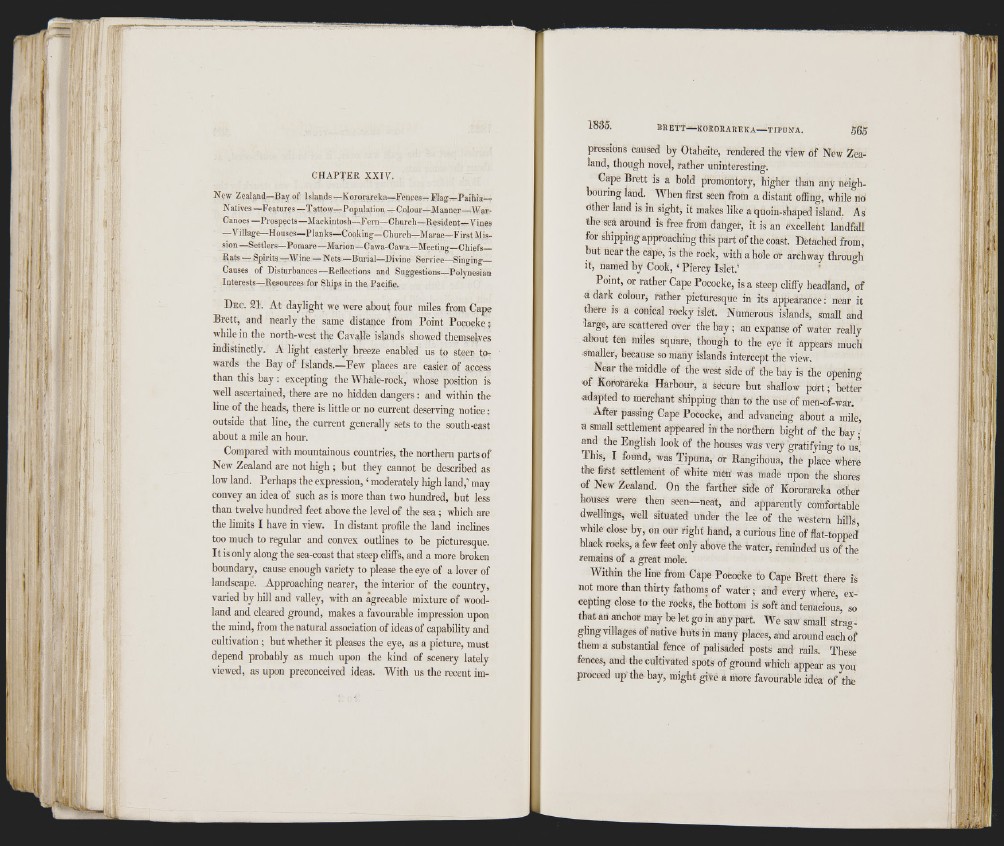
ii ' T-l-
>ir
A'ew Zealand—Bay of Islands—Kororareka—Fences— Flag—Paihia—
Natives —Features —T attow—Population —Colour—Manner—W ar-
Canoes —Prospects—Mackintosh—Fern—Church—Resident—Vines
—Village—Houses—Planks—Cooking—Church—Marae—First Mission
—Settlers—Pomare—Marion—Can-a-Cawa—Meeting—Chiefs_
Ruts — Spirits —Wine — Nets —Burial—Divine Service—Singing_
Causes of Disturbances—Reflections and Suggestions—Polynesian
Interests—Resources for Ships in the Pacific.
D e c . 21. At daylight we were about four miles from Cape
Brett, and nearly the same distance from Point Pocoeke;
while in the north-west the Cavalle islands showed themselves
indistinctly. A light easterly hreeze enabled us to steer towards
the Bay of Islands.—Few places are easier of access
than this bay : excepting the Whale-rock, whose position is
well ascertained, there are no hidden dangers: and within the
line of the heads, there is little or no current deserving notice:
outside that line, the current generally sets to the south-east
about a mile an hour.
Compared with mountainous countries, the northern parts of
New Zealand are not high ; but they cannot be described as
low land. Perhaps the expression, ‘ moderately high land,’ may
convey an idea of such as is more than two hundred, but less
than twelve hundred feet above the level of the sea ; which are
the limits I have in view. In distant profile the land inclines
too much to regular and convex outlines to be picturesque.
It is only along the sea-coast that steep cliffs, and a more broken
boundary, cause enough variety to please the eye of a lover of
landscape. Approaching nearer, the interior of the country,
varied by hill and valley, with an agreeable mixture of woodland
and cleared ground, makes a favourable impression upon
the mind, from the natural association of ideas of capability and
cultivation ; but whether it pleases the eye, as a picture, must
depend probably as much upon the kind of scenery lately
viewed, as upon preconceived ideas. With us the recent impressions
caused by Otaheite, rendered the view of New Zealand,
though novel, rather uninteresting.
Cape Brett is a bold promontory, higher than any neighbouring
land.^ When first seen from a distant offing, while no
other land is in sight, it makes like a quoin-shaped island. As
the sea around is free from danger, it is an excellent landfall
for shipping approaching this part of the coast. Detached from,
but near the cape, is the rock, with a hole or archway through
it, named b j Cook, ‘ Piercy Islet.’
Point, or rather Cape Pococke, is a steep cliffy headland, of
a dark colour, rather picturesque in its appearance: near it
there is a conical rocky islet. Numerous islands, small and
large, are scattered over the bay; an expanse of water really
about ten miles square, though to the eye it appears much
smaller, because so many islands intercept the view.
Near the middle of the west side of the bay is the opening
of Kororareka Harbour, a secure but shallow port; better
adapted to merchant shipping than to the use of men-of-war.
After passing Cape Pococke, and advancing about a mile,
a small settlement appeared in the northern bight of the bay;
and the English look of the houses was very gratifying to us.
This, I found, was Tipuna, or Rangihoua, the place where
the first settlement of white men was made upon the shores
of New Zealand. On the farther side of Kororareka other
houses were then seen—neat, and apparently comfortable
dwellings, well situated under the lee of the western hills,
while close by, on our right hand, a curious line of flat-topped’
black rocks, a few feet only above the water, reminded us of the
remains of a great mole.
Within the line from Cape Pococke to Cape Brett there is
not more than thirty fathoms of water; and every where, excepting
close to the rocks, the bottom is soft and tenacious, so
that an anchor may be let go in any part. We saw small strag-
glmg villages of native huts in many places, and around each of
them a substantial fence of palisaded posts and rails. These
fences, and the cultivated spots of ground which appear as you
proceed up the bay, might give a more favourable idea of tlie
I
rl T \
m i l
1Í i.